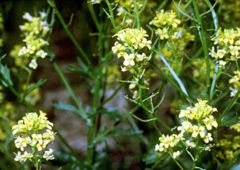Barbarea vulgaris
| Barbarea vulgaris subsp. var. | ||||||||||||||||||||||||||||||||||||||||||||||||||||||||
|---|---|---|---|---|---|---|---|---|---|---|---|---|---|---|---|---|---|---|---|---|---|---|---|---|---|---|---|---|---|---|---|---|---|---|---|---|---|---|---|---|---|---|---|---|---|---|---|---|---|---|---|---|---|---|---|---|

|
|
| ||||||||||||||||||||||||||||||||||||||||||||||||||||||
| ||||||||||||||||||||||||||||||||||||||||||||||||||||||||
Barbarea vulgaris, also called as Bittercress, Herb Barbara, Rocketcress, Yellow Rocketcress, Winter Rocket, and Wound Rocket, is a biennial herb native to Europe.
This plant has basal rosettes of shiny, dark green leaves, and pinnately divided leaves on the stem. The yellow flowers are borne in dense terminal clusters above the foliage in spring.
It is naturalised in many parts of North America as a weed.The flowers appear from about May through October. It grows to about 8-32 inches. Winter Cress prefers moist, disturbed fields.
| Standard Cyclopedia of Horticulture |
|---|
|
Barbarea vulgaris, R. Br. Common Winter Cress. Upland Cress. Yellow Rocket. Height 10-18 in.: lower Lvs. lyrate, the terminal lobe round, the lateral usually 1-4 pairs; upper Lvs. obovate, cut-toothed at the base. Eu. Asia.—-Cult. for salad, and also a common weed, making fields sulfur-yellow in early spring. Native far N., but apparently a settler in central states. Var. variegata, Hort., Lvs. splashed and mottled with yellow, is cult. as a border plant, and grows freely in rich soil. If the as. are picked off, st. and all, before they open, the plant will be practically perennial.
|
Cultivation
Propagation
Pests and diseases
The plant is naturally resistant to some insect species, such as the diamondback moth, Plutella xylostella. Other plant chemicals in this species attract cabbage white butterflies such as Pieris rapae.
Varieties
Gallery
-
photo 1
-
photo 2
-
photo 3
References
- Standard Cyclopedia of Horticulture, by L. H. Bailey, MacMillan Co., 1963
External links
- w:Barbarea vulgaris. Some of the material on this page may be from Wikipedia, under the Creative Commons license.
- Barbarea vulgaris QR Code (Size 50, 100, 200, 500)
